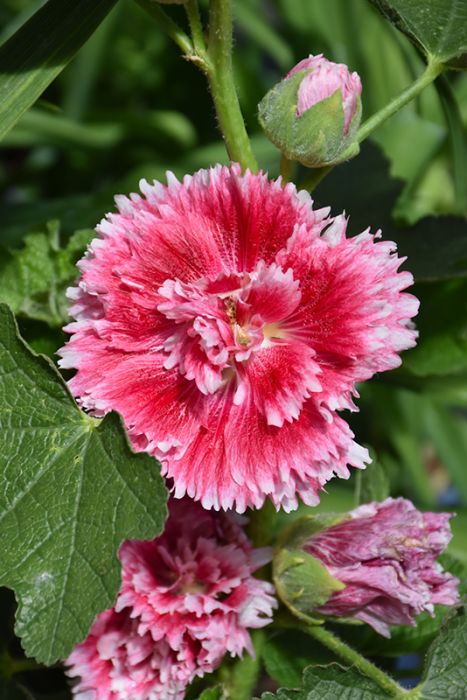Alcea, Compact Hollyhock 'Fiesta Time™'


Out of stock
Coming soon, still growing- Sun Preference
- Full-Sun
- Bloom Time
- June, July, August, September
Description
Compact plants bloom freely producing double, cerise pink blossoms with fringed petals. A short lived perennial that is tolerant to planting near Black Walnut trees.
Minnesota's Largest Selection of Perennials
Discover an unparalleled selection of perennials at Gertens! With the largest variety in Minnesota, we offer endless options of colorful perennials, natives, and pollinator plants to beautify your garden year after year. From vibrant flowers to lush foliage, our perennials are perfect for adding beauty and charm to your outdoor space. Visit Gertens today and see why we're known as Minnesota's Destination Garden Center!
Details
Fiesta Time Hollyhock | Alcea rosea 'Fiesta Time'
Plant Height: 24 inches
Flower Height: 3 feet
Spread: 15 inches
Sunlight: Full Sun
Hardiness Zone: 2b
Other Names: Althaea rosea, Compact Hollyhock
Description:
Beautiful, double cerise flowers with rose pink ruffled edges on a more compact plant; this biennial is tolerant to the natural toxin formed by the roots of Black Walnut, but can be susceptible to Japanese beetles; plant in full sun for better growth
Ornamental Features
Fiesta Time Hollyhock features bold spikes of crimson round flowers with rose edges rising above the foliage from mid to late summer. The flowers are excellent for cutting. Its tomentose lobed leaves remain green in color throughout the season.
Landscape Attributes
Fiesta Time Hollyhock is an herbaceous perennial with a rigidly upright and towering form. Its relatively coarse texture can be used to stand it apart from other garden plants with finer foliage.
This is a high maintenance plant that will require regular care and upkeep, and should only be pruned after flowering to avoid removing any of the current season's flowers. It is a good choice for attracting hummingbirds to your yard, but is not particularly attractive to deer who tend to leave it alone in favor of tastier treats. Gardeners should be aware of the following characteristic(s) that may warrant special consideration;
- Disease
- Self-Seeding
Fiesta Time Hollyhock is recommended for the following landscape applications;
- Vertical Accent
- Mass Planting
- General Garden Use
Planting & Growing
Fiesta Time Hollyhock will grow to be about 24 inches tall at maturity extending to 3 feet tall with the flowers, with a spread of 15 inches. It tends to be leggy, with a typical clearance of 1 foot from the ground, and should be underplanted with lower-growing perennials. The flower stalks can be weak and so it may require staking in exposed sites or excessively rich soils. It grows at a fast rate, and tends to be biennial, meaning that it puts on vegetative growth the first year, flowers the second, and then dies. However, this species tends to self-seed and will thereby endure for years in the garden if allowed. As an herbaceous perennial, this plant will usually die back to the crown each winter, and will regrow from the base each spring. Be careful not to disturb the crown in late winter when it may not be readily seen!
This plant should only be grown in full sunlight. It prefers to grow in average to moist conditions, and shouldn't be allowed to dry out. It is not particular as to soil type or pH. It is highly tolerant of urban pollution and will even thrive in inner city environments. This is a selected variety of a species not originally from North America.
More Information
| Common Family Name | Hollyhock |
|---|---|
| Gerten Grown Plants | Gerten Grown Plants |
| Available for Pre-Order | No |
| Sun Preference | Full-Sun |
| Bloom Time | June, July, August, September |
| Mature Spread (Range) | 12" - 24" |
| Mature Height (Range) | 25" - 36" |
| USDA Hardiness Zone | 2, 3, 4, 5, 6, 7, 8, 9 |




